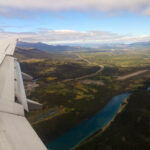Quail are intriguing birds, often observed scurrying on the ground, leading many to wonder about their aerial abilities. It’s a common misconception that quail are flightless, or at best, very poor fliers. You might have seen them take to the air in short, explosive bursts, especially when startled, but does this truly count as flight? So, let’s address the question directly: Do Quails Fly?
Yes, all species of quail are indeed capable of flight. However, their flight behavior is nuanced. While they possess strong wings, quail generally prefer to keep their feet firmly planted on the ground. Flight is often reserved for specific situations, making them seem like reluctant fliers at times.
It’s true that some quail species are more adept at flying than others, and we’ll delve into these differences. We will also explore the reasons behind their ground-dwelling preference. Keep reading to uncover the fascinating truth about quail and their flight capabilities.
Alt text: California Quail flock in dynamic flight, wings spread against a natural backdrop.
How Well Do Quails Fly?
Quail are equipped with surprisingly powerful wing muscles, enabling them to fly effectively when they choose to. Despite this physical capability, they are more commonly seen walking or running across the terrain. In fact, quail are quite speedy on the ground, capable of running at speeds reaching up to fifteen miles per hour. This terrestrial agility is a key part of their survival strategy.
Flight Distance: How Far Can Quails Fly?
Most quail species are capable of flying distances of approximately 100 yards (91 meters). Typically, they utilize flight for short bursts, primarily to reach safe roosting spots or to evade danger from predators.
If you’ve ever startled a quail, you’ll likely recall the sudden, noisy eruption as they take flight – a phenomenon known as “flushing.” This abrupt take-off can be startling for both bird and observer. For quail species that don’t migrate, flushing often represents the extent of their aerial journeys.
Alt text: Common Quail camouflaged in dense grass, showcasing its natural habitat and ground-dwelling behavior.
Flight Speed: How Fast Can Quails Fly?
When airborne, quail can achieve impressive speeds of up to 40 mph (64 kph). This raises the question: why don’t they spend more time soaring through the air? The answer lies in their body structure and lifestyle adaptations.
While their wings are powerful enough for rapid bursts of speed, many quail species are not built for sustained, long-distance flight. Their body composition and weight distribution are optimized for ground-based activities. Over generations, they have adapted remarkably to thrive in terrestrial environments.
Flight Altitude: How High Can Quails Fly?
Although generally ground-loving birds, quail possess the ability to fly to considerable heights, especially in short bursts. Their wings, while designed for quick escapes rather than long journeys, are quite powerful over short distances. This power allows quail to launch themselves almost vertically upwards when alarmed. This vertical flight capability is particularly useful, enabling them to reach branches in trees that are beyond the reach of many ground predators, providing a crucial escape route.
Alt text: Male and female California Quail perched atop a wooden post, demonstrating their ability to reach elevated positions.
Why Ground Dwellers? Quail’s Preference for Running
The apparent contradiction of a bird that can fly but prefers not to leads us to explore why quail are more inclined to run than fly. The primary reasons are deeply rooted in their habitat and survival strategies.
Quail habitats, across their diverse geographical range, typically consist of a mix of woodland and shrubland environments. These areas are rich in food sources, offer ample cover for hiding, and provide a sense of security. While these habitats may include trees and elevated perches for emergency escapes, the dense ground cover allows quail to blend seamlessly with their surroundings. This camouflage provides excellent protection, making running and hiding an effective strategy for evading predators.
Furthermore, running is a more energy-efficient mode of transportation for quail than flying. Conserving energy is vital for their survival, particularly depending on the season and the availability of food resources. In environments where food can be scarce, minimizing energy expenditure is crucial.
Alt text: Female Gambel’s Quail in flight, Arizona, USA, showcasing flight in its natural desert habitat.
When Do Baby Quails Start Flying?
Baby quail, known as chicks, typically begin to fly at around eleven days to two weeks old. Compared to many other bird species, quail chicks achieve flight capability relatively early in their development, demonstrating a degree of early independence.
By this age, they are capable of foraging for their own food and finding suitable resting places. However, despite their early flight ability, they remain vulnerable for approximately the first thirty days of their lives. During this period, their wings and legs are still developing, meaning they cannot run or fly as quickly or effectively as adult quail. For safety and protection, you will often observe quail chicks following closely behind their parents in a characteristic single-file line.
Alt text: Gambel’s Quail chick, highlighting the early developmental stage of a young quail.
Quail Migration: Do All Quails Migrate?
The answer to whether quail migrate is yes, some do, but migration is not universal across all quail species. Whether a quail migrates or not is largely determined by its genetic predispositions and the specific species.
Thanks to their powerful wings, certain quail species, notably the common or European quail (Coturnix coturnix), are capable of undertaking long migratory journeys. Some populations even migrate across oceans. Their migrations can span vast distances, from northern Europe to South Sahara in Africa.
Interestingly, migratory behavior can vary even within the same quail population. Some individuals will embark on extensive migrations, while others may travel only as far as the southern Mediterranean region. There are also quails that do not migrate at all, choosing to remain in one location year-round. In fact, the number of migratory quail appears to be declining in some areas.
This decrease in migration may be linked to shifts in weather patterns and changes in food availability. In regions where quail can now find sufficient food and shelter to survive throughout the year, they are adapting to a sedentary lifestyle. Migration demands a significant expenditure of energy, so it is only advantageous when absolutely necessary for survival. Quail that can successfully adapt to remaining in a single area may have a higher chance of survival in changing environments.
Alt text: European Quail in its habitat, emphasizing the quail’s elusive nature and camouflage.
Quail Flying FAQs
Are Quail Flightless Birds?
Quail are definitively not flightless birds. They possess a strong capacity for flight and will readily take to the air when needed. Their preference for ground-dwelling is primarily a matter of lifestyle and habitat adaptation, not a lack of flight ability. When startled or threatened, they will quickly flush upwards to reach safety, often seeking refuge in trees or other elevated locations.
However, given a choice, quail will typically opt to escape danger on foot. Their natural habitats provide abundant ground cover, which often makes running and hiding a more effective and energy-efficient escape strategy than flying away.
Why Do Quails Have a Feather on Their Head?
The distinctive cluster of curled feathers adorning the head of many quail species is known as a top-knot or plume. This feature is present across several quail species and can be observed in both males and females, although it is often more pronounced in males. The most compelling explanation for the plume’s existence relates to genetics and breeding. Female quail often show a preference for males with a well-developed, vibrant plume over males with a less impressive plume or no plume at all. A healthy, prominent plume is thought to signal a healthy male who is likely to pass on desirable genes to his offspring, making it a key element in mate selection.

